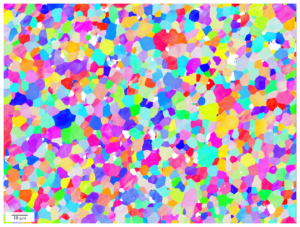
Electron back-scatter diffraction can be used to identify the phase, crystal structure, orientation and texture of a material. A sample is placed at a 70° angle, and an electron beam scans across its surface. The electrons undergo Bragg diffraction, and back-scatter to the detector. Kikuchi bands (stripes of detected electrons across the detector) are observed, which are characteristic of specific crystal structures at specific angles. EBSD therefore analyses the crystal structure and orientation at each point on its surface. This describes the texture of the material, which has significant effects on its mechanical properties.
Figures
Figure One: Example of an EBSD mapping showing grain orientations variations across the sample surface (On a W-Mn sample)
